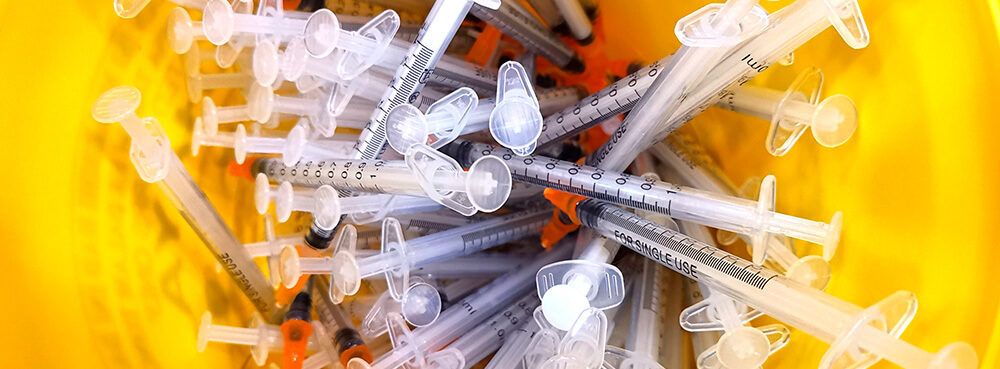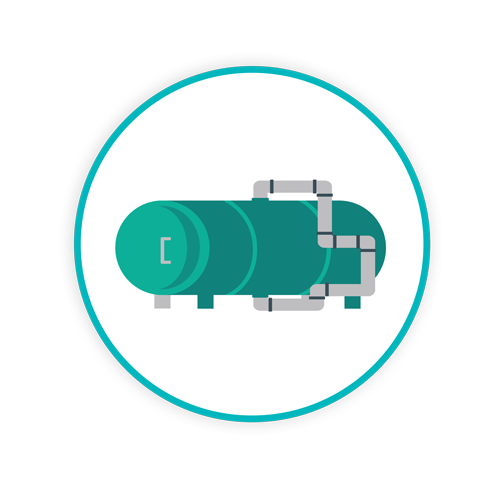What Happens to Sharps Waste?

Beyond providing care to patients, Canadian healthcare facilities must also make sharps waste management a part of their daily routine. However, to handle this waste appropriately, it is essential for a facility's staff to be familiar with the rules and regulations concerning the storage and disposal of this waste.
It is possible that your staff may be able to identify the different types of sharps but not be aware of how to properly store and dispose of them. That’s why it’s important to provide continuous training and refresher information on how to dispose of sharps waste in order to remain compliant with all regulations.
Your staff likely knows that they must put used sharps in a sharps container. However, some staff members may not understand what is done with the waste next. Sharps waste is a type of regulated medical waste, and staff members must comply with all federal, provincial, and municipal regulations when disposing of it.
TOPICS WE WILL COVER:
1 / Are Used Sharps a Form of Biomedical Waste?
2 / How to Dispose of Sharps
3 / Which Agency Makes the Regulations Covering Sharps Disposal
4 / Sharps Containers
5 / Preparing Sharps for Safe Disposal
6 / Daniels Health Can Help Keep Your Facility Safe and Compliant Wherever You Are in Canada
Are Used Sharps a Form of Biomedical Waste?
Sharps are a type of biomedical waste. According to the Canadian Biosafety Handbook, biomedical waste is "waste generated in human and animal health care facilities, medical or veterinary research and training facilities, clinical testing or research laboratories, as well as vaccine production facilities."
This waste includes sharps, such as syringes, blades, needles, and glass that is contaminated with infectious material that could cause cuts or puncture wounds. Therefore, medical facilities that use sharps need to be familiar with both Canadian government regulations and municipal and provincial regulations. There are Canada-wide guidelines covering some types of waste. However, these regulations only apply if the province or municipality in which your medical facility is located adopts them.
It is also important to remember that some sharps may be considered a type of hazardous waste that includes toxic and infectious substances. Canada's sixth classification of hazardous waste consists of toxic and infectious substances. According to the Canadian Centre for Occupational Health and Safety, substances included in this category can "cause death or serious injury or harm to human health if swallowed, inhaled, or in contact with skin.”
Additionally, medical and clinical waste can be considered infectious waste if it contains regulated properties. One of the most common ways for healthcare workers to become infected by these substances is through needlestick injuries. The sharps most commonly involved in these injuries are disposable syringes, suture needles, scalpel blades, and IV-stylets. Some illnesses that healthcare workers can contract this way are Hepatitis B or C, and HIV, among others.
How to Dispose of Sharps
Sharps must be disposed of according to the regulations of your municipality, province, and territory. So, it is vital that your employees be trained in the appropriate procedures. As an example, Quebec requires that "Biomedical waste destined for shipment from its generation site shall be put into rigid, sealed, leakproof containers, which shall be perforation resistant if they contain sharp medical objects or sharp household objects." However, the Canadian Biosafety Handbook states that "Sharps waste is disposed of directly into a puncture-resistant container in accordance with National Standard of Canada (CAN)/CSA Standard CAN/CSA Z316.6, Sharps Injury Protection- Requirements and Test Methods- Sharps Containers."
Medical facilities need to ensure the containers they use comply with all federal guidelines. For medical sharps, the guidelines indicate that containers for sharps are colour-coded yellow and that the label includes the biohazard symbol. Guidelines also recommend that the puncture-resistant container that will be used for sharps disposal be located as close as possible to where they will be used. This will minimise the risk of injury during the disposal process.
Federal Guidelines
Employees need to know how to handle and store biological waste. One important source of information about this subject is section 16.2 of the Canadian Biosafety Handbook. So, employees who handle biological waste should read and be familiar with this information. One example of the information provided in this section is "If waste is not decontaminated and disposed of immediately, it may be stored temporarily provided that it is in a designated area that is separate from other storage areas and clearly marked with a biohazard symbol. Some types of waste (e.g., human anatomical waste, animal waste) needs to be stored in a refrigerated area to prevent putrefaction." These types of regulations must be followed to ensure safe storage and disposal.
Provincial and Municipal Guidelines
In addition to federal guidelines, healthcare facilities must comply with provincial and municipal guidelines. Municipal and provincial agencies will likely have specific guidelines to follow for medical waste streams. This is particularly likely for biomedical and hazardous wastes. Your province should follow federal guidelines when applicable, but your facilities will also have to follow provincial guidelines. Provincial guidelines can be located on the website of your regional government.
Which Agency Makes the Regulations Covering Sharps Disposal
There are several agencies in charge of creating regulations covering the safe handling and disposal of sharps. As stated above, you will find provincial guidelines on regional government websites. Section 16.2 of the Canadian Biosafety Handbook has some federal guidelines.
You can find even more information in this handbook by referencing Chapters 16 through 20. You can also find additional information in the Canadian Biosafety Standard, Third Edition. This handbook provides healthcare facilities with information concerning definitions, packaging, segregating, and acceptable treatment options for biomedical waste, no matter which province your medical or healthcare facility is located in.
For instance, the guidelines state that "Decontamination of all biomedical waste prior to disposal in the regular waste stream is essential to the protection of public health, animal health, and the environment. It is important to segregate and dispose of biomedical waste near the point that the waste is generated." The information in these guidelines can be very useful for ensuring compliance with federal regulations.
Sharps Containers
All Canadian provinces are required to comply with the specified instructions for healthcare waste disposal based on waste streams. For example, below are the requirements for sharps waste containers in Ontario.
Single-Use Sharps Waste Containers
A single-use sharps container should:
- Be made of rigid materials that are puncture-resistant and leak-resistant.
-
Have a lid that cannot be removed after the container is sealed.
Reusable Sharps Waste Containers
A reusable sharps container should:
- Be made of rigid materials that are puncture-resistant and leak-resistant.
- Have a lid that is securely attached to the container that can be closed and locked when the container is full.
- Designed or intended by the manufacturer to be suitable for reprocessing and reuse.
As you can see, there are very specific requirements, so it’s essential to align with a waste solution provider that is an expert in the various requirements throughout the country. Daniels Health has perfected the first reusable Sharpsmart container system which has been intentionally designed to help prevent needlestick injuries.
Preparing Sharps for Safe Disposal
Sharps waste is no longer classified as biomedical waste once it has been decontaminated. So, it is general practice to decontaminate sharps before they are disposed of. This is typically done through autoclaving, incineration, and grinding.
Medical autoclaves are devices that are used to sterilise medical devices by exposing them to steam under pressure. Once sharps waste is decontaminated in an autoclave, it can be sent to a facility to be incinerated. However, any sharps waste that is not yet decontaminated or might contain toxic materials must be segregated from other types of medical waste before it is shipped to another facility to be incinerated and disposed of.
This is particularly important for waste from laboratories or research and pharmaceutical facilities. In fact, if you are transporting waste from any of these types of facilities, it is essential to be familiar with the regulations in the Dangerous Goods Regulations (DGR), Transportation of Dangerous Goods Act (TDGA), and the Transportation of Dangerous Goods Regulations (TDGR).
These guidelines must be followed in all Canadian territories and provinces since they have all adopted these regulations along with their own medical waste regulations. The guidelines cover important requirements when transporting or shipping any infectious substances or biological materials inside of Canada.
Daniels Health Can Help Your Facility Keep Safe and Compliant Wherever You are In Canada
With so many different federal and provincial laws covering the disposal of sharps as well as other types of medical waste, it can be difficult to remain compliant. Handling the disposal of sharps can be confusing. But, the regulations exist to ensure everyone's safety and protect the environment. Daniels Health is not only a waste management solution, but also helps facilities plan and select the best products and services for their specific location. If you would like information or help in dealing with sharps waste, reach out to Daniels Health today.
